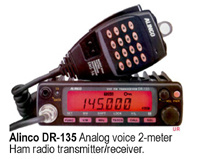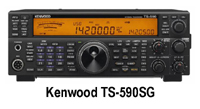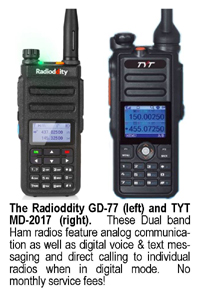21st Century Ham Radio
This is Not Your Grandfather’s Ham Radio!

By: David Deschesne, KB1EBG
Editor/Publisher, Fort Fairfield Journal
In the past, I have published articles critical of conventional modes of communication such as cell phone, landline and internet during emergency scenarios when the grid that supports those communication infrastructures will not be working.
Ham radio is an excellent way to maintain communications ability without relying on that fragile and easily compromised communications grid.
Within the confines of Ham radio you can enjoy “chat rooms” and social networking as millions of users have for over 100 years. These chat rooms come in the form of voice, text and even Morse Code and other digital communications (though knowledge of Morse Code is no longer required to obtain a Ham license). With Ham radio, there’s always somebody to talk to whether it’s in the next town, or on the other side of the world—and those communications can be obtained without access to internet, landline or cell grid. There are no monthly fees in Ham radio. It’s all free to use, but Ham radios require an FCC license to operate. Licenses, which come in various levels, are free, after a modest multiple choice test is passed, are good for ten years, and are renewable for free every ten years, for life.
Leaving a Message with Ham Radio
I was recently asked if one could call and leave a message on Ham radio, or if that was even practical. The answer is, Yes, you can leave messages on Ham radio and there are several ways you can do it.
practical. The answer is, Yes, you can leave messages on Ham radio and there are several ways you can do it.
The first way is electronically using a vintage mode called Packet radio. In Packet radio (usually used in the local, 2-meter VHF frequency band but can be used on short-wave, too) you send a message via computer over the radio; it sends it out as a “packet” of digital information with control data and error correction either directly to the recipient, or relayed through a network of computers also on that frequency. Each receiving computer will error-check the information before forwarding it. Thus you would in a sense have a message waiting for you in your “inbox” but the message format is very streamlined and simple compared to today's e-mail over internet.
It's important to keep in mind that in Ham radio, messages are transmitted in open air, “in the clear” whether they be voice or digital, so everyone with a similar computer setup will be able to receive and read the messages that are sent. I don't think many people are set up for Packet in this area at this point in time, but some did experiment with it in the past as a hobby. In addition to Packet radio, there are several other digital modes that can be used either on local, VHF frequencies, or the longer, short-wave HF frequencies. These modes are PSK-31, Slow-scan TV, Fax, Winlink (a form of e-mail over Ham radio) and others. D-Star is also a new format which enables computers to be linked directly via Ham radio and even allows for streaming internet data over Ham radio (providing the base station is connected to an internet access hub).
The second way to leave a message is done manually. That is, especially on short-wave, messages are passed via Ham radio operators over long distances using standardized hand-written message forms (see example, above right). There is a sender and receiver and each person in the link attempts to contact the area where the message is intended to arrive. Depending on the atmospheric conditions and the distance you’re trying to send the message, it could end up being relayed through several Ham radio operators on the way before it gets to its destination. Once the ham radio operator receives the message in the target area, he then attempts to contact the recipient in any way possible. This could be by mail, phone or in person. The final recipient need not be an amateur radio operator. This format is generally used in grid-down emergency situations such as the aftermath of a hurricane or other catastrophic emergency where conventional modes of communication have been compromised and will remain inoperable for some period of time.
A third way to receive messages - at least when someone is calling you - is to set up a recorder (either digital or tape) to voice activated mode and listen to a frequency predetermined between you and friends.
In Ham radio, the way a call is made using voice is with the call sign of the person you are trying to reach, followed by your call sign. For example, if I was trying to call Ivan Shapiro, the president of the local Aroostook Amateur Radio Association, on Ham radio, I would key the microphone and say, “WK1W this is KB1EBG, Over.” Generally, we Hams will repeat that call several times over a couple of minutes to make sure the person we are trying to reach gets a chance to hear and respond. This is what constitutes an initial “call” on Ham radio.
Now, when one of your friends attempts to call you using the standard call sign format as noted above, the recorder will record that activity if you're not near the radio to hear it. When you get back to your radio and “check your messages” you can at least hear who tried to reach you on the radio.
Keep in mind that while Ham radio is operated “in the clear” and anybody can legally listen to another person's conversation, it is illegal to record someone without their informed consent. So, within the confines of an unused frequency in the local, 2-meter band (of which there are many to choose from in Ham radio), you should be in compliance with the law if you let your friends who may be calling you know that their initial call may be recorded.
Finally, there is Digital Mobile Radio (DMR) which acts as a sort of closed circuit telephone system between ham users, featuring both voice and text messaging. More on that in the next section.
The Equipment
Ham radio equipment requires a license to transmit, but to simply receive and listen no license is required. Below are some examples of current radios for both local use and long-distance as well.
For local use, the 2-meter VHF radios will do fine. They are comparable to the radios used by police, fire, ambulance and businesses but they are designed to transmit only on the authorized Ham radio frequency bands.
The more expensive HF radios enable users to communicate over vast distances using relatively little power and a reasonably simple antenna built out of standard house wire.
All Ham radio equipment operates on 12-volts DC and can be immediately installed in any vehicle with a 12-volt system. These radios can also be used as base stations indoors, but will require a 12 volt DC power supply of adequate current, or you may set up an off-grid power supply by using a 12-volt Marine Deep Cycle battery (or several, depending on the capacity you want to have) that is charged either via a standard car battery charger, from solar panels, or a small wind generator.
Prices on these units range from $160 to $200 for the local 2-meter VHF units. Plan to spend around $600 to $1,500 for a decent 100 watt long distance HF unit.
2-Meter VHF
These radios are the size of a standard CB radio, but with much more power. They can be usedanywhere with an appropriate 12-volt DC power source. Power outputs range from 5 watts to 85 watts, depending on model. For most local communications, 5 to 15 watts is more than adequate. All radios feature a telephone keypad for accessing repeaters that have a telephone landline link activated.
Short-Wave HF
There are many options to choose from in the long distance, short-wave HF radios. These will allow you to communicate reliably out to around 300-500 miles and across the country or around the world, depending on atmospheric conditions and which Ham frequency band you choose.
These modern radios all operate on 12-volts DC, so they are great for emergency use. They also are able to be connected to a computer running Ham radio software to allow users to communicate via the many Ham digital formats available.
 Whether you choose VHF or HF, you will need an antenna and source of 12-volts DC power. The HF radios also require an antenna tuner. Some models have the tuner built in while others have it sold separately. My favorite choice for HF radios is the Kenwood TS-590SG, shown below. It has 100 watts of output (though I’ve only used at most 55 watts for world-wide communications) and a built-in antenna tuner. I also like the Alinco DR-135 for local, VHF use (see above).
Whether you choose VHF or HF, you will need an antenna and source of 12-volts DC power. The HF radios also require an antenna tuner. Some models have the tuner built in while others have it sold separately. My favorite choice for HF radios is the Kenwood TS-590SG, shown below. It has 100 watts of output (though I’ve only used at most 55 watts for world-wide communications) and a built-in antenna tuner. I also like the Alinco DR-135 for local, VHF use (see above).
Digital Mobile Radio
Around 2015, a new mode of communication for Ham radio was introduced, borrowing from the commercial world of Digital Mobile Radio (DMR), that communicates digitally via voice or text messaging. The TYT MD-2017 or Radioddity GD77, for example, are compatible with the Motorola MotoTRBO digital format and can send and receive texts and voice messages digitally among Ham radio users in the authorized Ham radio bands. These radios also allow you to program in the call sign and radio ID number of other Ham radio operators and enable you to send out a call or text message to an individual radio discreetly within a local area. While a repeater infrastructure has been built in larger metropolitan areas for DMR, this format is currently still too new for a repeater system to be available in the Northern Maine area. But as their popularity grows, local radio clubs may invest in that infrastructure. DMR can be used locally between two radios, with a repeater to extend their local range, or they can connect to the internet via Wi-Fi and access any internet connected DMR repeater in the world for instant communication world-wide under normal, non-emergency conditions where the grid is in normal operation. For emergency communication, DMR should be considered a secondary format due to the quirkiness of digital modes. DMR radios are free to use. They do not require contracts, like cell phones, and there are no monthly service fees. DMR radios cost between $90 to $180 per unit.
Motorola MotoTRBO digital format and can send and receive texts and voice messages digitally among Ham radio users in the authorized Ham radio bands. These radios also allow you to program in the call sign and radio ID number of other Ham radio operators and enable you to send out a call or text message to an individual radio discreetly within a local area. While a repeater infrastructure has been built in larger metropolitan areas for DMR, this format is currently still too new for a repeater system to be available in the Northern Maine area. But as their popularity grows, local radio clubs may invest in that infrastructure. DMR can be used locally between two radios, with a repeater to extend their local range, or they can connect to the internet via Wi-Fi and access any internet connected DMR repeater in the world for instant communication world-wide under normal, non-emergency conditions where the grid is in normal operation. For emergency communication, DMR should be considered a secondary format due to the quirkiness of digital modes. DMR radios are free to use. They do not require contracts, like cell phones, and there are no monthly service fees. DMR radios cost between $90 to $180 per unit.
All photos of the equipment shown herein (except for the GD-77 radio) are from Universal Radio's website, which is a good place to buy new equipment (they did not pay me for this mention). However, there is at times used equipment available from local Hams looking to sell and there is a large "Ham Fest" outdoor Ham radio garage sale in the Bangor area at least once a year. You may visit the local Aroostook Amateur Radio Association website for contact information and to research used Ham radio equipment that might be available in the Northern Maine area.









